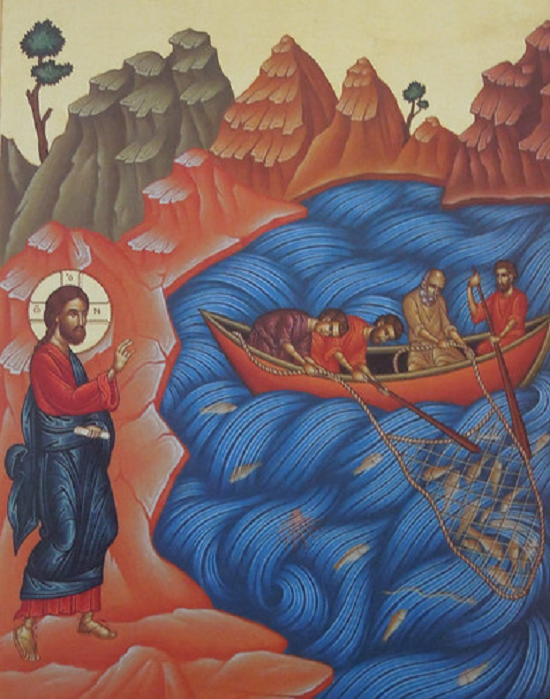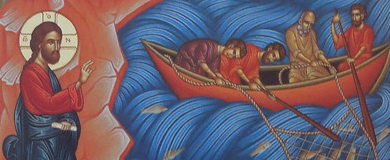A Supplement for the Church
Third Sunday of Easter Scripture Readings

As I mentioned last week, the original version of the Saint John’s Gospel ended with chapter twenty. The passage we read today, from chapter twenty-one, is a supplement to the Gospel. At the same time, no source of the Gospel is without it, so we know it’s original to the first published edition and not a later add-on. However, the authorship of this section remains uncertain. Although it certainly derives from the school that grew up around the Beloved Disciple, whether it’s from the evangelist himself remains an open question. The possible differences in authorship and the fact that the passage is a supplement to the original text explains, but doesn’t resolve, many of the disconnects between it and the body of the Gospel. We’re very aware that John manipulates events—particularly their timing—to illustrate his points, but these differences go beyond that.
All the previous appearances of the Resurrected Jesus in the Gospel of John—as well as for Matthew and Mark—take place in Jerusalem. Without transition or explanation, we now find Jesus and seven of the Apostles in Galilee at the Sea of Tiberias, which was an alternate name for the Sea of Galilee. We’re not told when or how they got there, or why. Furthermore, the description of the Apostles’ reactions at seeing Jesus on the shore was one of shock, suggesting that this might be the first of Jesus’s appearances to them. That possibility is irreconcilable with the rest of John’s Gospel. Finally, this passage, which evidently would have taken place some time after the Resurrection, shows the Apostles returning to their former way of life. None of the gospels, nor the Acts of the Apostles, nor the letters of Saint Paul hint at such a thing. If the disciples were, indeed, transformed by their witness of the Resurrection and if, indeed, they had received the gift of the Holy Spirit and had been given the mission to go out to all the world and spread the Good News, why would they have given up and gone back to fishing? It’s not plausible.
So, what can we surmise was the purpose behind this supplement? It could only have been a message of instruction and encouragement to believers in the nascent Church. The work of Peter and the other disciples was clear: they were to be fishers of mankind. Miraculous catches of fish in the gospels were evident symbols of the successful mission of the Church to draw all peoples together into a faith community. Whenever a large number of people joined their ranks—as we know they did—the Apostles must have felt that the Lord was behind it because the results far exceeded their skills or powers to produce such results. When the people flocked to them, how could they help but exclaim, “It is the Lord!”?
The image we’re presented with is decidedly sacramental. The fish obviously represent new converts—notice that Jesus doesn’t cook or eat any of the fish from this catch. What about the number “153”? Is there any symbolism to that? The answer to that question is forever lost to history. So, by a power not their own, the Apostles find themselves “catching” converts and bringing them to Jesus in the rite of Baptism where they become members of the Body of Christ, the Church.
In the text, the Apostles bring the fish to the shore, where Jesus has prepared a meal of fish and bread. Readers must immediately connect this with the multiplication of the loaves and fishes from back in chapter six. This is a clear reference to Jesus’s gift of spiritual nourishment to his people in the Church through the Eucharist. Remember that this was composed no more than fifty or sixty years after the Resurrection. At that time, the Eucharist was still closely attached to the agapē meal, a sort of Christian Passover celebration. It had not yet been reduced to its essential elements: the Bread of Life and the Cup of Eternal Salvation. In short, the Apostles were discovering that the power of the Holy Spirit, acting through them, was drawing great numbers of people into the boat of the Church where they were leading them to the shore where Jesus was waiting to feed them with the Eucharist. It is there, in the Eucharist, where the encounter with Jesus takes place.
The final scene is both an encouragement and a warning to the Christian community. Every one of the evangelists acknowledges the primacy of Peter among the Apostles. They often speak of “Peter, James, and John,” or “Peter and the other disciples,” always singling Peter out because of his faith—“You are the Christ, the Son of the Living God”—and his evident enthusiasm. Here the evangelist highlights Peter’s unique mission among the Apostles as the one charged by the Good Shepherd to ensure the wellbeing of his sheep. Again, there are Eucharistic overtones to this mission. The sheep are to be fed with the Word of God and the Bread of Life. The triple commission brings this home powerfully. Jesus asks, “Do you love me with all your heart?” Peter answers, “You know I like you a lot.” “Feed my lambs.” And again, “Do you love me with all your heart?” And again, “You know I like you a lot.” “Pasture my sheep.” Finally, Jesus relents. “Do you like me a lot?” And this saddens Peter. “Yes, Lord, you know that I like you a lot.” “Feed my sheep.” In other words, Jesus calls those who would follow him to love as overwhelmingly as he has loved, but he accepts the best we’re able to give. Our best is good enough.
The Church is still the place where the lost and abandoned are gathered in, where they’re offered the chance to die to the old, perishable, self-centeredness and rise to a new life of everlasting love and life and to be fed with the Body and Blood of Jesus, the anointed, the Messiah. The Church of Peter and the Apostles is where we find our way out of hopelessness, confusion, and darkness into hope, peace, and light. The Church is called to be the image of Christ in the world by the way we love. If we’re disappointed in the way Christ’s Church expresses that love, we’re not alone. Jesus must have thought to himself, “Is that all you can offer me, Peter?” and yet, Peter’s mission remained intact and continues still despite our imperfections. Although it scatters at least as many fish as it gathers, through our love, the nets still hold, and, somehow, the lambs and sheep are still being fed with the Word of God and the Bread of Life.
Now the Lord asks, “Do you love me with all your heart?” Can we truthfully answer, “Lord, you know everything. You know that I love you with all my heart.”? Regardless of how weak our answer may be, he still says to us, “Feed my sheep.”
Get articles from H. Les Brown delivered to your email inbox
